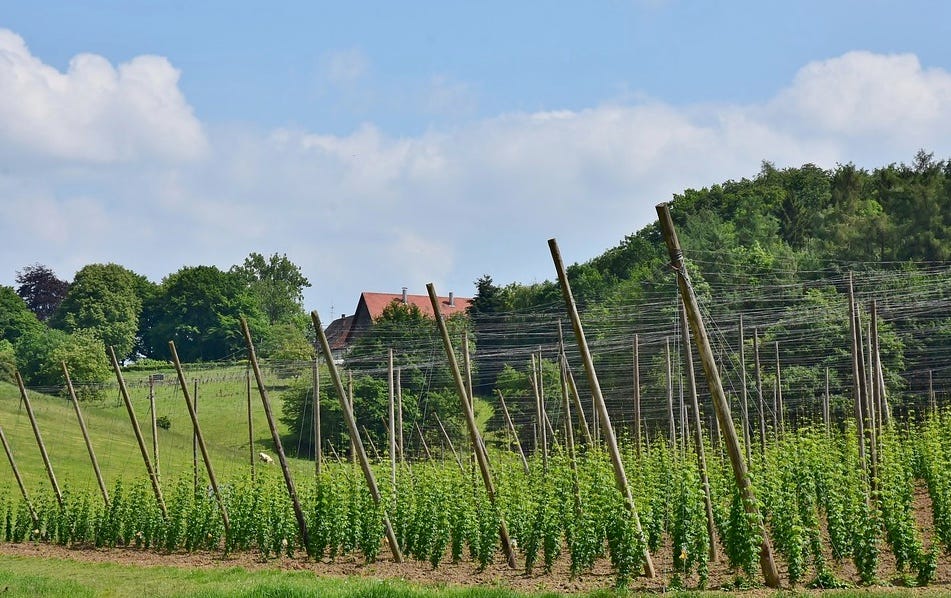What VW must do to catch Tesla; Buffett's climate slight, and green beer gets its day
Welcome to Callaway Climate Insights. To celebrate our first anniversary, we're cutting our annual subscription price by 20% this week. Please share, and subscribe!

It’s always hard to think of Volkswagen without conjuring Herbie or Nazis or Dieselgate from 2015, but the fact that the German auto giant has survived so much is testament to its staying power, as well as the seemingly unbreakable brand loyalty to its cars. Now VW is reinventing itself for the electric age, and taking on Tesla (TSLA).
Volkswagen’s (VLKAF) shares surged almost a third this week after the company laid out plans to build six battery factories in Europe and deliver more than 1 million electric vehicles by 2023, which would put it ahead of Tesla’s pace.
Contrast this to the spat Lordstown Motors (RIDE) is in this week with a short seller over the credibility of orders, or the scandal over the Nikola Corp. (NKLA) last year, and it’s clear that the real battle for the future of electric cars is in the hands of the big boys — VW, Tesla, General Motors (GM), Ford (F), BMW, etc.
Tesla, by virtue of being first to market and its charismatic leadership, is the early leader, and its stock performance reflects that. But attempts to write off the others misreads the arc of auto history. VW in particular has three things going for it.
First, it’s based in Europe, where the regulatory environment and public desire for electric cars are projected to lead to half of all new sales being electric in a few years time, vs. a small percentage in the U.S.
Second, VW is focusing on the batteries, specifically lithium-ion batteries. It is an investor in QuantumScape (QS), the California maker of solid-state batteries for cars, while Tesla has more industry-standard battery technologies. It’s likely the batteries, in particular how cheap they become and how long they last, will decide the race on EVs, as opposed to flashy designs and car commercials.
Third, as the demand curve steepens, manufacturing capacity becomes even more critical. This is Tesla’s weak spot, and one the Volkswagen Group — which owns Audi, Bentley, Bugatti, Lamborghini, Porsche, and Volkswagen — is implicitly aiming for. Much will be made of manufacturing numbers as EV sales heat up in Europe and the U.S. in the next few years. Investors in Volkswagen have been burned many times before. But like the plucky Herbie, they keep coming back.
More insights below. . . .
Don’t forget to share Callaway Climate Insights with your friends and colleagues this week while our 20% anniversary sale is on! Contact me directly if you have suggestions or ideas at dcallaway@callawayclimateinsights.com.
Tuesday’s insights: Buffett’s climate resolution diss, and the $131 trillion clean energy tab
. . . . Warren Buffett raised eyebrows two weeks ago when he left any real mention of environmental, social and governance investing or transition to clean energy out of Berkshire Hathaway’s annual shareholder letter. This week, it emerged he’s ignoring a shareholder resolution to increase climate disclosures. Is Buffett’s conspicuous absence from the ESG markets trend just old school, or does he know something else? Read more here. . . .
. . . . Even by the new standards of trillion-dollar Covid relief plans and climate spending programs, the International Renewable Energy Agency’s (IRENA) call this week for $131 trillion in global spending on clean energy by 2050 seems a budget plan too far. While the alternative is likely more expensive, cash-strapped nations will find it hard to rise challenges like this without better short-term incentives. Read more here. . . .
Sorry, St. Patrick. There has always been green beer.
. . . . In more than 5,000 years of beer drinking, nobody has ever really ordered a green beer. But that doesn’t mean they haven’t been around, and won’t be going forward as decarbonization techniques take hold. Gunnar Wetlesen takes a St. Patrick’s Day look at the history of green beer as the industry looks to its green future. . . .
Happy National Panda Day

. . . . Pandas, a symbol of global conservation efforts, are no longer considered “endangered,” but after 50 years of work to save their fragile forest habitat, the wild population has grown from 1,114 to only 1,864. More work is needed, the WWF says. Pandas live mainly in temperate forests high in the mountains of southwest China, where they subsist almost entirely on bamboo. They must eat around 26 to 84 pounds of it every day. Despite their bulk, they are excellent tree-climbers, says the WWF. . . .
News briefs: Jet fuel from food waste, bladeless wind turbines
Editor’s picks:
Scientists cook up jet fuel from food waste
It just blew in: A tiny bladeless wind turbine
LG adds $4.5 billion spark to its U.S. battery production
Data driven: Turn up the heat a little
. . . . Natural gas had an eventful February, hitting the headlines in Texas and reaching an average price of $5.35 per million British thermal units (MMBtu) in February, the highest nominal monthly average since the icy-cold snow-filled February of 2014, and nearly double January’s $2.71/MMBtu average price, according to the EIA. The price spiked in February due to colder than usual temperatures and decreased production due to well freezes.
The EIA expects Henry Hub spot prices to fall back to Earth in the second quarter of 2021 to $2.88/MMBtu and predicts an average price of $3.14/MMBtu in 2021 — considerably higher than 2020’s $2.03/MMBtu average price. The increased price is expected to cause natural gas consumption to drop .9% when compared to 2020 averages due to reduced use for electricity generation. Natural gas is predicted to account for 36% of the power in the U.S.’s electric grid in 2021, down from 39% in the year prior — George Barker






